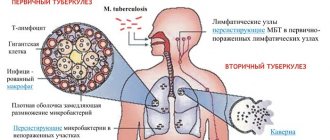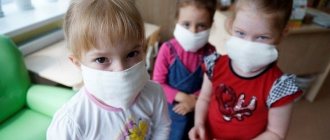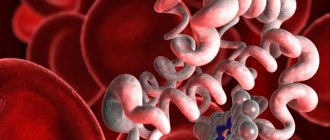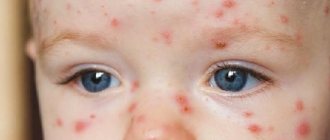Chickenpox is an infectious disease caused by the herpes virus Varicella Zoster. The pathogen is transmitted from one infected person to another through airborne droplets. The pathology is acute in nature and occurs with pronounced symptoms: vesicular rash, high temperature, fever, etc. It is believed that a person who has had chickenpox has lifelong immunity against the disease. However, this is not entirely true. In rare cases, doctors note re-infection with chickenpox in patients.
Features of the pathology
Chickenpox is an acute reaction of the immune system to the introduction of the V.Zoster virus into the body. The disease is highly contagious, that is, it is easily transmitted from one sick person to another. The pathogen enters the body by embedding itself in the mucous membranes.
The disease normally occurs in several main stages:
- Infection and incubation period. At this time, the virus integrates into epithelial cells and begins to multiply rapidly. There are no clinical symptoms, the patient’s health is normal.
- Initial symptoms of the disease. The pathogen enters the bloodstream and spreads throughout the body. The human immune system begins to produce antibodies to destroy the virus. This process is accompanied by deterioration of well-being, pain in muscles and joints.
- Acute phase. The virus enters the endings of nerve cells and integrates into them. During the same period, the patient develops a characteristic vesicular rash, which is a specific reaction of the body to the presence of Varicella Zoster.
- Recovery phase. The number of rashes gradually decreases, the patient's condition noticeably improves.
This is how chickenpox occurs in a first-time patient. In people who have already had chickenpox, the pathology can manifest itself with atypical symptoms and lead to a number of complications. The most common are:
- stomatitis or gingivitis;
- otitis;
- pneumonia;
- nephritis;
- pain of unknown etiology;
- arthritis;
- hemorrhagic smallpox - the appearance of a rash with bloody exudate.
Attention!
Chicken pox also occurs severely in people over 18-20 years of age who become ill for the first time. To avoid the development of pathology, it is recommended to resort to vaccination as a preventive measure.
Complications
Despite the fact that until recently this disease was considered mild, the consequences of chickenpox in adults can be quite serious. If the rash has spread to the mucous membranes, in the future (with weakened immunity) it may appear on the internal organs. The peculiarity of the mucous membranes is that it is difficult for rashes to dry out on them - they turn into erosions and take much longer to heal. Erosions on internal organs bleed, which can lead to the development of internal bleeding. In some cases (with liver damage), areas of necrosis may form.
In the absence of proper skin care, when bacteria enter the area of scratching, as well as when the function of the immune system is significantly weakened, suppuration may occur on the skin. Inflammatory diseases of internal organs may also develop: pneumonia, hepatitis, nephritis, encephalitis, meningitis, endocarditis, and others. The most common cases are pneumonia and damage to the nervous system, which are quite severe against the background of chickenpox. The mortality rate for the development of chickenpox encephalitis can reach 20%.
Formation of immunity
After the first reaction to the introduction of Varicella Zoster into the cells of the nervous system, the immune system begins to produce immunoglobulins. These are specific structures aimed at identifying and neutralizing various pathogens. Immunoglobulins destroy viruses and body cells that have been damaged by the action of the pathogen. After the infectious process in the body is stopped, most of the antibodies die. However, a small part of them mutate and become so-called memory cells. These are structures that allow the body to recognize Varicella Zoster and immediately destroy the virus if it begins to become active.
In some people, for a number of reasons, the immune system is completely unable to produce memory cells, or they die several months or years after having chickenpox. In this case, the patient may get chickenpox again if he encounters an infectious carrier of the virus.
Attention!
Science has not yet been able to establish for what reasons some people lose the memory cells responsible for developing immunity to chickenpox. In medical practice, there have been several cases where patients contracted chickenpox more than 3-4 times.
How to avoid getting chickenpox?
To avoid infection, you should not take your child to kindergarten if there is a chickenpox quarantine; a protective mask in this case does not provide a 100% guarantee of safety. Many doctors believe that it is better to get over this “childhood infection” in time, since adults and adolescents have a hard time with chickenpox with high fever and complications.
The risk of complications is especially high in unimmunized adults, that is, those who were not sick in childhood and were not vaccinated against chickenpox. Chickenpox is dangerous for pregnant women due to possible disability of the child, and for infants from non-immunized mothers. In such cases, severe forms of the virus may develop: gangrenous, hemorrhagic, bullous.
Author:
Melnikova Svetlana Georgievna, dermatologist
Is it possible to get chickenpox again?
In most cases, people who have had chickenpox once are no longer at risk of contracting this infection. However, in approximately 3-5% of cases, patients get it again. Relapse of the pathology occurs against the background of a depressed state of the immune system. The developed immunity to chickenpox is non-sterile. This means that after suffering from the disease, a person not only remains immune to chickenpox, but the virus itself continues to exist in the patient’s body. The causative agent is located in the spinal ganglia, that is, in the endings of nerve cells. In most cases, the virus remains inactive in cells and continues to exist for decades.
It is due to the fact that pathogens are located in the cells of the nervous tissue that the immune system continues to constantly produce antibodies to them. Re-infection with chickenpox is possible in two cases:
- The immune system produces an insufficient amount of antibodies, as a result of which the virus that has entered the body from the outside begins to actively multiply.
- Varicella Zoster is activated due to a sharp weakening of the human immune system. Elderly people are most susceptible to this.
Attention!
Cases of repeated chickenpox occur in adults in more than 80% of cases, but children can also become infected again. This indicates that the child’s immune system is suppressed due to some other, more severe pathology. In addition, symptoms similar to chickenpox can occur with a number of other diseases: scabies, allergies, dermatitis, etc.
Video - Is it possible to get chickenpox again?
Is it possible to become infected with chickenpox after contact with a sick person?
Chickenpox infection occurs through airborne droplets or household contact. According to medical research, infection occurs within five minutes after being in a closed room if there was contact with a patient suffering from an active form of the disease.
Chickenpox is most often transmitted by airborne droplets. It is difficult to protect yourself from the disease, since already in the prodromal period the patient can get herpes of the third type, but the patient himself is not yet aware of his condition. A person remains infectious for 24 hours before the rash appears and at all times when new vesicles are present.
Another case is a special, deliberate infection, when parents bring small children to come into contact with sick children in order to become infected with chickenpox and transfer the disease as early as possible. A household contact route is also possible if a child touches a patient who has burst vesicles.
Chicken pox and herpes zoster
Varicella Zoster can cause two diseases with a similar clinical picture and etiology: chickenpox and herpes zoster. While chickenpox mostly affects children, shingles most often develops in adults or the elderly. Both pathologies have the following symptoms:
- The onset of the disease is acute: the patient complains of a sharp disturbance in health, headache, and fatigue. On examination, febrile fever up to 39-39.5°C is noted.
- After 12-48 hours, vesicles form on the patient’s skin and epithelium - small pock-shaped vesicles filled with transparent or whitish content.
A characteristic difference between lichen and chickenpox is that the rashes with herpes zoster are located along the nerve trunks, which is caused by damage to cell processes by the virus. Vesicles are usually localized in the intercostal space, collar area, neck and cheekbones. The rash that has formed gives the patient intense pain, which can only be relieved with the use of local and general analgesics.
Attention!
The causative agent of herpes zoster can provoke disturbances in the functioning of the central nervous system. When this pathology is detected, in most cases the patient requires hospitalization.
Shingles develops due to exposure to the same pathogen as chickenpox and has clinical manifestations similar to it. That is why the pathology in some cases is diagnosed as a repeated case of chickenpox or its complication.
Diagnosis: chicken pox. What to do next?
In the absence of aggravating factors, such as early age (less than 1 year), severe symptoms of poisoning (febrile temperature, refusal to eat and drink), symptoms of damage to the nervous system, as well as suspicion of an immunodeficiency state, home bed rest is usually prescribed, recommended for the entire period of rashes. If the disease is severe, high fever persists for more than a day, hospitalization is necessary.
If the patient receives medications (cytostatics or corticosteroids), the risk of bacterial infection is high, so hospitalization in the infectious diseases department is also indicated.
To fight the virus and restore strength, you must adhere to a special diet. A dairy-vegetable diet is prescribed, which is gentle mechanically and thermally. Especially in case of damage to the oral mucosa, so as not to further injure the elements of the rash and prevent the development of a bacterial infection. You should not force-feed your child. Your appetite will return on its own after some time.
Drinking plenty of fluids will help relieve your condition.
. You can offer the patient compotes, neutral mineral water without gases, warm jelly in small portions, but often. This will help compensate for fluid loss at elevated temperatures and reduce symptoms of intoxication.
It is important to pay attention to hygiene; it is recommended to change bed linen more often and regularly wet clean the patient’s room. The child is allowed to bathe if the temperature remains at normal values until all the crusts fall off.
Classification of chickenpox
| Type | Severity | Flow |
| Typical | Lightweight | Smooth (without complications) |
| Atypical | Medium-heavy | The appearance of complications (adding bacterial infection or manifestation of chronic diseases) |
| Generalized (with damage to internal organs) | Heavy | The appearance of complications (adding bacterial infection or manifestation of chronic diseases) |
Treatment
Depending on the child’s condition and the course of the disease, the doctor determines treatment tactics along with general recommendations for patient care. Antiviral drugs are not prescribed for mild and moderate forms of the disease. For severe disease, the following are recommended: acyclovir, vidarabine. But only a doctor can diagnose the form of the disease and calculate the dose of medication!
Mandatory symptomatic therapy includes:
- antipyretics for fever, if the temperature rises above 38.5 degrees (approved antipyretic medications for children: ibuprofen and paracetamol);
- It is recommended to treat the rash with aniline dyes (1-2% solution of brilliant green or methylene blue) twice a day, applying the product pointwise to each element of the rash, making sure not to damage the cap of the bottle;
- It is recommended to rinse the oral cavity with herbal decoctions (chamomile, sage), use antiseptics (tantum verde, hexoral, miramistin, a weak solution of potassium permanganate, as well as a solution of hydrogen peroxide 3%) or solutions with an anti-inflammatory effect (tonsilgon);
- severe itching and agitation of the child can be alleviated by prescribing antihistamines (including such as fenistil, zyrtec, etc.);
- In cases of symptoms of a bacterial infection, it is recommended to prescribe antibiotics.
Video - How to treat chickenpox in adults
Who is at risk?
The secondary development of chickenpox is observed in people with impaired immune function. In this case, the virus manifests itself in the form of shingles, affecting the abdomen, armpits, neck and shoulders.
The following groups of people are susceptible to re-infection with chickenpox:
- Patients who have undergone any major operations, organ and tissue transplantation, blood transfusions, etc.
- People with suppressed immunity, including people with HIV and AIDS and patients taking drugs with cytostatic effects.
- Patients with autoimmune diseases: systemic lupus erythematosus, crest syndrome, rheumatoid arthritis.
- Patients with chronic pathologies: peptic ulcer, diabetes, disruption of the endocrine system, etc.
- People who are constantly exposed to stress, neuroses and mental pressure.
Diseases similar to chickenpox
There are also a number of diseases whose clinical symptoms are very similar to those of chickenpox. However, these pathologies have a different etiology. Most often, when diagnosed as chickenpox, other disorders caused by the herpes virus are mistakenly diagnosed. Modern medicine identifies eight main types of herpetic infections.
Comparative characteristics of herpes viruses
| Pathogen name | Localization in the body | Symptomatic manifestations |
| Herpes pathogen 1 | Trigeminal nerve cells | Herpes lesions of the mucous membranes of the eyes and mouth, encephalitis |
| Herpes pathogen 2 | Nerve endings of the sacroiliac symphysis | Rash in the genital area, meningoencephalitis |
| The causative agent of chickenpox and herpes zoster 3 | Spinal nerve endings | Chickenpox, herpes zoster |
| Epstein-Barr virus | B lymphocytes, mucous membranes of the nasopharynx | Infectious mononucleosis, Burkitt's lymphoma, nasopharyngeal carcinoma, B-cell lymphoma |
| CMV | Leukocytes, mucous membranes, salivary glands, renal tubules | Cytomegalovirus infection, dysfunction of the central nervous system, retinitis, pneumonia, hepatitis, general viral damage to the body |
| Human herpes type 6 | B lymphocytes | Skin lesions in children under two years of age |
| Human herpes type 7 | Undefined | Skin lesions - exanthema |
| Human herpes type 8 | Undefined | Multiple hemorrhagic sarcomatosis |
Attention!
There can be several different types of herpes virus in the human body. In this case, a combined infection develops, which is manifested by various signs of a particular strain of the pathogen.
In acute infectious diseases caused by intestinal viruses, patients also develop blistering rashes on the epidermis and epithelium. When misdiagnosed, such pathologies are mistaken for the development of chickenpox.
Chickenpox is an acute reaction of the body to the introduction of a pathogen into cells. Most patients, after suffering from chickenpox, develop stable immunity to the pathogen. However, in some cases, under the influence of various factors, the human body does not produce the antibodies necessary to suppress the virus, which can lead to the secondary development of chickenpox.
The disease has receded
Recovery occurs in uncomplicated forms no earlier than ten days from the start of the disease.
Often, after an illness, the immune system is weakened and the child is more susceptible to viral and bacterial infections. In order to strengthen the defenses, courses of immunomodulatory drugs and multivitamin complexes are prescribed.
Medical supervision is established for children who have suffered a severe generalized form of chickenpox, complicated by damage to the nervous system or other organs. In this case, it will be necessary to examine specialists: an ophthalmologist, a neurologist, an otolaryngologist, a gastroenterologist, as indicated.
Rare but serious complications
Chickenpox occurs in most cases without complications. But those rare cases of severe disease, which occur in 2% of cases, can lead to serious consequences: disability or death.
Among the non-dangerous, but long-term complications are: purulent skin diseases, which develop when a newly opened blister of bacteria gets on the pustule. Children cannot cope with severe itching and scratch the blisters, causing infection.
Less common:
- brain damage (meningitis, encephalitis);
- changes in the heart (myocarditis, heart rhythm disturbances);
- pneumonia (pneumonia);
- inflammation of the conjunctiva of the eye (keratitis);
- arthritis (inflammation of large joints);
- liver and kidney damage.
These diseases develop more often in adults and, with timely treatment, are reversible.
Especially important
! Chickenpox carries enormous risks for women during pregnancy, especially in the first months. This disease threatens the development of defects in the fetus and can cause a “frozen” pregnancy. If a pregnant woman has had chickenpox before giving birth, the antibodies do not have time to protect the child. In this case, the newborn develops a severe infection, often leading to the death of the child.










